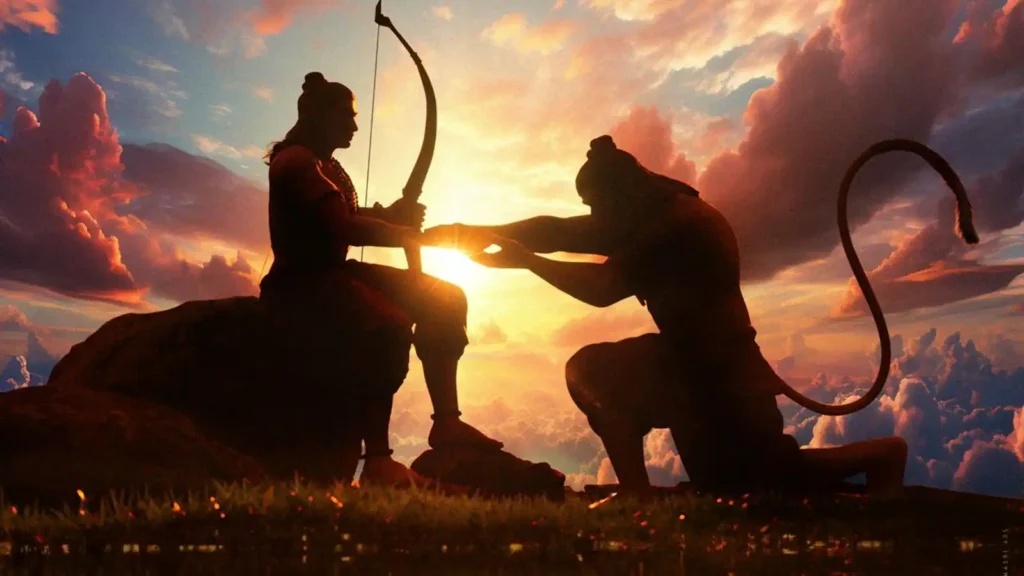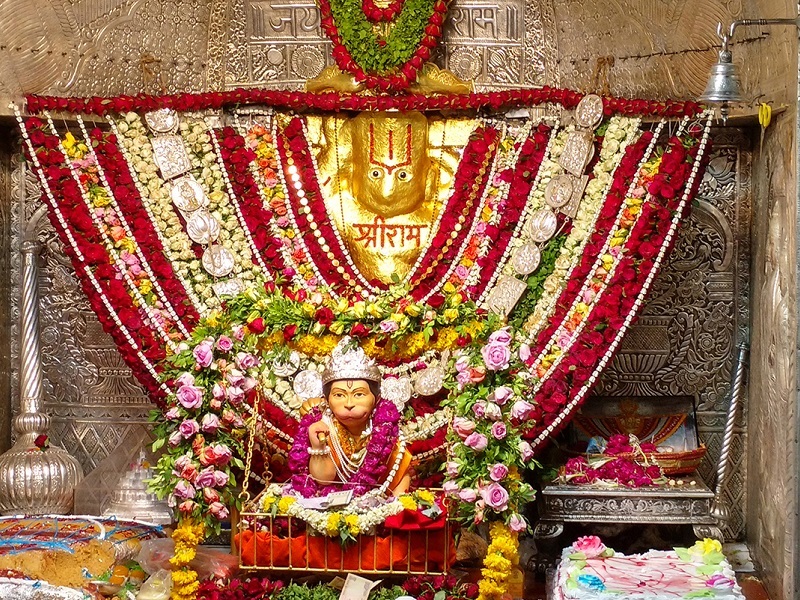Jay Siya Ram | Jay Hanuman. Welcome to RishiSaar – a palce to find all the things related to Sanatan Dharma and Hindu scriptures. Here, we will see the untold story of Hanuman’s son. Many people are confused when they first hear the term son of Hanuman as Hanuman followed Brahmachariya. In the same way, you will have many questions such as when and how was son of Hanuman born, who is the son of Hanuman, where are the temples, etc. We will answer each of these questions here.
Did Hanuman Have a Son?
Hanuman, the divine devotee of Lord Rama and an incarnation of Lord Shiva, is often considered a celibate (Brahmachari). However, some ancient texts mention a son of Hanuman, Makardhwaja, born under miraculous circumstances. Though Hanuman remained celibate, the story of his son is a unique narrative found in certain versions of the Ramayana and Puranas.
Who is the Son of Hanuman?
Makardhwaja is considered the son of Hanuman, though not in the conventional sense. He is described as a great warrior with immense strength, much like his father. His story is primarily found in regional versions of the Ramayana, especially in the narratives of the Ananda Ramayana and folk traditions. Some Puranic texts also mention his existence, highlighting his role as a guardian of Patal Lok.

How Was the Son of Hanuman – Makardhwaja Born?
The birth of Makardhwaja is unique and divine. According to legend, after burning Lanka with his tail during the search for Sita, Hanuman took a dip in the ocean to cool himself. As he immersed in the water, a drop of his perspiration fell into the mouth of a mighty Makara (a mythological sea creature or crocodile). This divine drop resulted in the birth of Makardhwaja within the belly of the Makara.
Later, the Makara was caught by the fishermen and cut open, revealing the child inside. The baby, possessing extraordinary strength, was adopted by Ahiravana, the king of Patal Lok (the Netherworld). Ahiravana, an ally of Ravana, raised Makardhwaja as his own son and made him the guardian of the gates of Patal Lok.
When Hanuman Met Makardhwaja for the First Time
The first encounter between Hanuman and Makardhwaja occurred when Hanuman went to rescue Lord Rama and Lakshmana from Patal Lok. Ahiravana had tricked them and taken them to his underground kingdom to sacrifice them. As Hanuman entered Patal Lok, he was stopped by a powerful warrior – none other than Makardhwaja.
Hanuman, unaware of his relation to the young warrior, asked for his identity. Makardhwaja introduced himself as the son of Hanuman, astonishing the mighty Vanara. Hanuman, though skeptical, realized the divine circumstances that led to Makardhwaja’s birth. However, duty bound Makardhwaja to prevent Hanuman from entering Patal Lok, leading to a battle between father and son.
Battle of Hanuman and Hanuman’s Son Makardhwaja
A fierce battle ensued between Hanuman and Makardhwaja. Despite his immense power, Makardhwaja was ultimately defeated by Hanuman. However, upon learning the truth of his birth and Hanuman’s mission to rescue Lord Rama and Lakshmana, Makardhwaja surrendered. Hanuman, pleased with his son’s devotion and valor, appointed him as the ruler of Patal Lok after defeating Ahiravana.
Mentions of Hanuman’s Son in Ramayana
The primary Valmiki Ramayana does not mention Makardhwaja, but his story appears in the Ananda Ramayana, a later retelling. Additionally, various folk traditions and regional Ramayanas narrate the tale of Makardhwaja as an extension of Hanuman’s adventures. Some versions also mention Makardhwaja’s devotion to Lord Rama, making him an ardent follower like his father.
The following texts mention Makardhwaja:
- Ananda Ramayana – This later Ramayana text provides details about Hanuman’s journey to Patal Lok and his battle with Makardhwaja.
- Brahmanda Purana – Mentions Makardhwaja as the guardian of Patal Lok.
- Mahabhagavata Purana – Briefly references Hanuman’s unknown son.
- Tulsidas’ Ramcharitmanas (regional adaptations) – Some oral traditions refer to Makardhwaja.
Temples of Makardhwaja – Hanuman’s Son
A temple dedicated to Makardhwaja is located in Dwarka, Gujarat, near the famous Dwarkadhish Temple. This temple is believed to be one of the rare places that worship Hanuman’s son. According to legends, this is where Makardhwaja was made the ruler of Patal Lok by Hanuman after defeating Ahiravana. The temple is visited by devotees seeking blessings for strength, courage, and devotion.

The Hanuman Dandi Temple is a Hindu temple located on Beyt Dwarka, an island off the coast of Gujarat, India, dedicated to the deity Hanuman and his son Makardhwaj. Situated approximately 5 kilometers from the Dwarkadhish Temple in Bet Dwarka, this temple is unique as it features idols of Hanuman and Makardhwaj, showcasing a rare depiction of Hanuman, who is traditionally considered a celibate, with his progeny

The temple structure reflects ancient architectural styles and features sculptures depicting the battle between Hanuman and Makardhwaja. Priests here perform special rituals in honor of both father and son, emphasizing their devotion to Lord Rama.
Temples dedicated to Makaradhwaja can be found in India, especially in Gujarat, India where the Jethwas once ruled. Some noted temples in Gujarat and other places in India are at:
- Hanuman Dandi temple at Bet Dwarka, where idols of Makaradhwaja and Hanuman are worshiped together.
- Mandvi, of both Makaradhwaja and Hanuman
- Odadar village near Porbandar
- Chinchawan, Wadwani, Maharashtra
- Karahiya near Gwalior, Madhya Pradesh
- Balaji Makaradhwaja, temple at Beawar, Rajasthan which is dedicated to both father-son duo in form of Balaji Hanuman and Makaradhwaja
Conclusion
The story of Hanuman and his son, Makardhwaja, is a fascinating narrative that highlights divine intervention and destiny. While Hanuman remained celibate, the miraculous birth of Makardhwaja shows that even the most disciplined beings can have unexpected legacies. Their battle and eventual union depict the eternal bond of duty, devotion, and divine purpose. Though lesser-known, Makardhwaja’s story remains an integral part of Hanuman’s legend in various scriptures and folk traditions. His temple in Dwarka stands as a testimony to his significance in Hindu scriptures.


